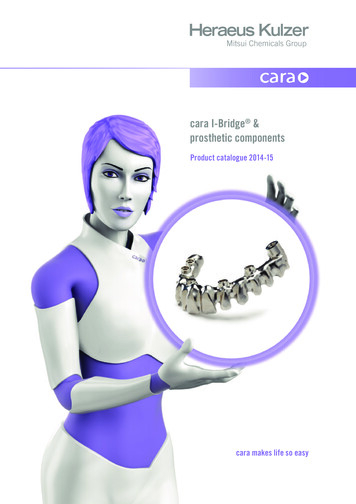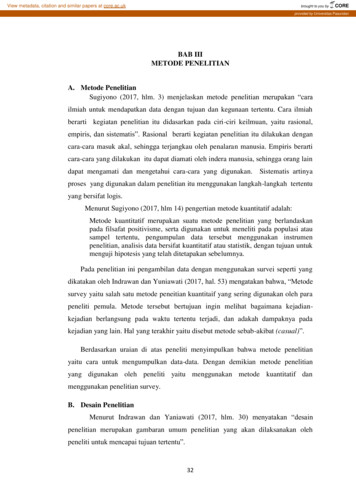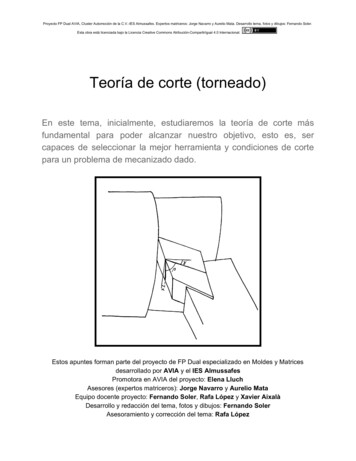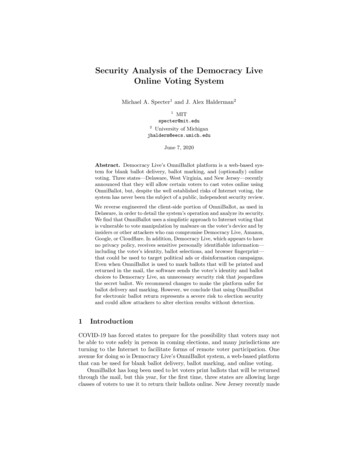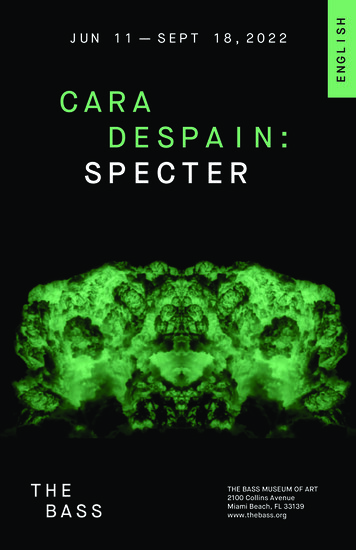
Transcription
CARADESPAIN:SPECTERTHE BASS MUSEUM OF ART2100 Collins AvenueMiami Beach, FL 33139www.thebass.orgENGLISHJUN 11—SEPT 18,2022
CARA DESPAIN:SPECTERJUN 11 — SEPT 18, 2022Cara Despain’s practice addressesthe difficult history and legacy ofterritory expansion, industrializationand empire building in the UnitedStates. Through site-specificresearch processes, she visualizesthe current geological age, theAnthropocene, by exposing theconsequences human activity hason ecosystems and the environment.In her recent work, Despainexplores nuclear weaponsdevelopment — including theobscure history of testing bombsand mining uranium in the AmericanWest, using the midcentury AtomicAge and Cold War era as a lensto interpret the present loomingthreat of nuclear war. In Specter,Despain presents video, sculptureand installation created withfound objects and archival filmfrom the 1930-60s, to underscorethe irreversible environmentalconsequences while conveyingthe hidden psychological effectsand cultural memory left in thewake of weapons developmentand testing. Impacts from bothgovernment-sponsored activitieswere particularly devastating in theartist’s home region of the ColoradoPlateau (encompassing parts ofUtah, Navajo Nation, Colorado,Arizona and New Mexico), but carrylarger global implications andaftereffects to this day. Startingwith the micro — her own familyhistory, adjacent local historiesand living memory — Despainlinks parallel and hidden narratives,arriving at a macro view of theliteral and figurative fallout of thenation’s push for globalmilitary supremacy.At the entry to the exhibition, houseof cards (2022) shows the end titlecards from educational films andPSAs created by the US Departmentof Civil Defense, other militaryentities, and corporations, repeating“The End” in an indistinguishable,ominous loop. Disseminated mostlyin the 1950s and 60s during theheight of nuclear testing at theNevada Test Site, these filmswere intended to educate peopleabout how to protect themselvesagainst nuclear fallout, while alsoencouraging support for nuclearweapons technology to defendthe country against the threat ofcommunist invasion. The filmswere meant to convey scientificand analytical information aboutthe tests, as well as militarypropaganda to school childrenand general audiences. Somefilms were regionally specific toareas “downwind” of testing, suchas Newscastle/Cedar City, Utah,where Despain’s mother grew up,though actual advanced warningsabout tests had a limited reach.However, when the educationaland ideological content of thearchival films is removed, house ofcards only shows the nonspecificfinality of the phrase “The End” ona continuous loop. This repetitionleaves the viewer unsure of what isending—a documentary, a horrorfilm, PSA or a fairytale?
Cara Despain, test of faith (2021), 3 channel digital video installation, (3:39).Courtesy of the artist. Photo Credit: Cara Despain.Despain’s works and the desertshall blossom as the rose (2022),and under the rainbow, behindthe curtain (2022) explore theambivalence of uranium, whichwas used in both nuclear bombsand popular domestic glassware.The works feature curio cabinetscontaining mass-producedDepression Era glass dishware anddecorative objects that containuranium oxide as a colorant. In1942 at the onset of the ManhattanProject — the American-led effort todevelop a functional atomic weaponduring World War II — all uses ofdomestic uranium, including as tintfor glass, were banned. ChoosingArt Deco-style pieces and arrangingthem in an architectural installation,Despain conjures the aspirationsof a glittering era just before theIron Curtain came down as well asthe insidious implications uraniumwould go on to have. The acidgreen and vaseline yellow uraniumcontaining glass fluoresce in UVlight, glowing a brilliant green in thelined cabinets.Nearby, also emitting anotherworldly glow, Iodine-131 (2022)is a topography cast out of concreteof the Nevada Test Site, createdusing Google Earth satellite imageryto produce a geo-accurate reliefsculpture. Civilians are not allowedto view this site on the ground, butthe scars from testing are visiblefrom space.Despain’s film, test of faith (2021)uses recently restored and digitizedfilms of nuclear weapons tests fromthe Nevada Test Site — located amere 65 miles from Las Vegas andless than 150 miles from where hermother and grandmother were born
Cara Despain, under the rainbow, behind the curtain (2022), wood, antique depression glass and UVlights. Courtesy of the artist. Photo Credit: Cara Despain.and raised — heavily researched byDespain to grasp the far-reachingimplications of the legacy ofnuclear testing.From 1951-62, there were 100atmospheric atomic bomb testsconducted at the Nevada Test Site,many of which were considerablylarger than the bombs droppedon Japan. Tens of thousands offilms were taken of these tests onhyper-sensitive film stock to collectdata and to preserve and documentthe development of the US nucleararsenal. Most of these films werekept hidden from the public eye,but in recent decades many havebeen digitized, declassified andreleased in an effort to renderfuture need for such testingobsolete. Altering the images ofthe fireballs and atomic clouds tocreate Rorschach test-like imagery,Despain obscures the iconic militaryand cultural propaganda images ofmushroom clouds — which werewidely utilized in cultural ephemerafrom Hollywood films and sci-fibooks to punk band album covers.— into a psychological, hypnoticmeditation on the precariouspresent and future of militarism andweapons- development. The film’ssoundtrack is a layered versionof the Mormon hymnal “Love OneAnother” Despain created as a playon the appeal made by the militaryspecifically to the many Mormonsettlers in the fallout region, aswell as to the entire country, tosupport the testing under the guiseof united patriotism. Capturingthe spectacle of testing was anendangerment of the cameraoperators — especially in theearly days when the radioactivefallout was purportedly not
fully comprehended. Like manydownwind civilians near testsites, many of these filmmakersworking in secret fell ill with cancer.Although their work was perhapsthe most important in terms ofmaking this awesome and awfulendeavor visible, and documentingthis dark period of history, like thefilms featured in Despain’s workson view today the filmmakersremained unseen for decades.The ghostly, cinematic stagingof works in Specter provides ahistorical context as well as ahaunting reminder of the obscuredhistory and hidden injusticeburied in the legacy of the ColdWar. Impacts from both domesticuranium mining and atomicweapons testing were particularlydevastating in the artist’s homeregion, but also continue toreverberate across the entire globeto this day. Despain notes, “Specteris a glimpse into the quasispiritual, otherworldly, dark sharedconnection that quite literallyradiated out from the day we firsttested and continues to haunt thebodies of every living thing onthe planet.” It is an atmosphericmonument to having irrevocablycrossed the threshold into theAnthropocene, and into a nuclearage that continues to push us to anexistential precipice.Cara Despain, under the rainbow, behind the curtain (2022), wood, antique depression glass and UVlights. Courtesy of the artist. Photo Credit: Cara Despain.Aim your phone’s camera at the QR code here for moreinformation on the exhibition or visit:https://thebass.org/art/specter
RELATED PROGRAMMINGFor more information on The Bass' upcoming events, subscribe to ournewsletter at: thebass.org/newsletterCara Despain: Specter is curated by Leilani Lynch. The exhibition is part of the Knight ArtCommissions Program funded by the John S. and James L. Knight Foundation. Generous support isprovided by The Andy Warhol Foundation for the Visual Arts.The Bass is generously funded by the City of Miami Beach, Cultural Affairs Program, Cultural ArtsCouncil, the Miami-Dade County Department of Cultural Affairs and the Cultural Affairs Council,the Miami-Dade County Mayor and Board of County Commissioners; and the State of Florida,Department of State, Division of Arts and Culture and the Florida Council on Arts and Culture; andThe Bass membership.
Utah, Navajo Nation, Colorado, Arizona and New Mexico), but carry larger global implications and aftereffects to this day. Starting with the micro — her own family history, adjacent local histories and living memory — Despain links parallel and hidden narratives, arriving at a macro view of the . CARA DESPAIN: SPECTER. JUN 11 — SEPT 18, 2022

